Growing into the Framework: D51’s Implementation Strategy
CompetencyWorks Blog

This article is the fifth in the Designing Performance-Based Learning at D51 series. A reminder: D51 uses the phrase performance-based learning or P-BL.
Growing into the Framework
Superintendent Steve Schultz doesn’t ask “How are we going to implement?” Instead he thinks, “We have forty-four schools. How are they each going to grow into the framework?” The job of the district is to help learn, grow, and co-create with schools the new performance-based system (P-BL). The answer is through a more personalized approach that lets schools and educators start where they are in their current learning and move forward from there.
Five Phases of Implementation
Everything is in motion at District 51, and everyone is moving forward with the understanding that the different pieces will eventually need to be aligned. Thus, everything is draft and everything stays open until related work is done. Paul Jebe, Director of Educator Effectiveness, likened it to the whirling tea cups at Disneyland, bringing back that experience of loving every spin while simultaneously praying that it might be over soon.
Still in their first year of implementation, D51 has intensive activity in three of their five phases of work underway – so don’t make the mistake of thinking phase suggests sequence. There is a cohort of seven demonstration schools that are hungry to put the entire model into place as soon as it is ready. (When they sign up to be a demonstration school they are committing to demonstrating to others what performance-based learning looks like – it’s important to understand that they are not pilots.) The trick is that given the simultaneous development of many of the pieces, the demonstration schools might find themselves operating in the third phase even if they are missing some pieces from phases one or two. In a few more years, there will be efforts underway, schools and educators in all five phases as they continue to design, refine, skill-build, and engage.
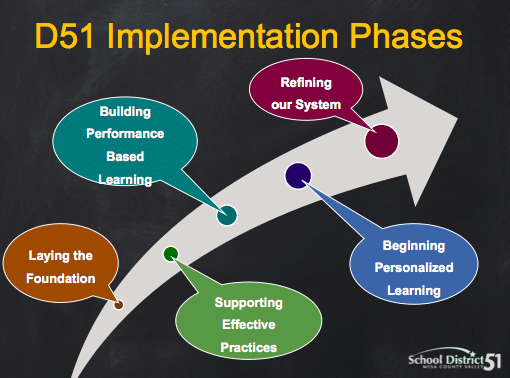
Remember, D51 describes the journey to transformation described in the previous article separately from the implementation strategy. Both are important – the journey captures the new conditions (strong learning culture, shared vision, collective ownership, personalized, transparency, and data-driven) that will shape the system (i.e., the paradigm shift), and the phases are how the work is being organized. Below is a quick scan of the phases and the different sets of work underway.
Laying the Foundation: There are a lot of pieces for laying the foundation, including clarifying the pedagogical philosophy, making sure everyone understands why the shift to P-BL and the implementation strategy are necessary, and putting into place the essential ingredients for moving to implement a full P-BL system.
The essential ingredients really are the core of the work: laying the cultural foundation, emphasizing growth mindset, and building social-emotional learning (S&EL). Consider this the bedrock of the pedagogical philosophy at D51 of what is needed for students to learn, grow, and become self-directed learners. The demonstration schools have had support in introducing these into their schools, and some others schools have already moved into this stage on their own.
Another part of Laying the Foundation is the courageous step of developing new processes, called holacracy, to replace the bureaucratic routines used by most districts. (You can read about D51’s approach to holacracy in the previous series post.)
Below is the outline of steps in Laying the Foundation phase as described by D51:
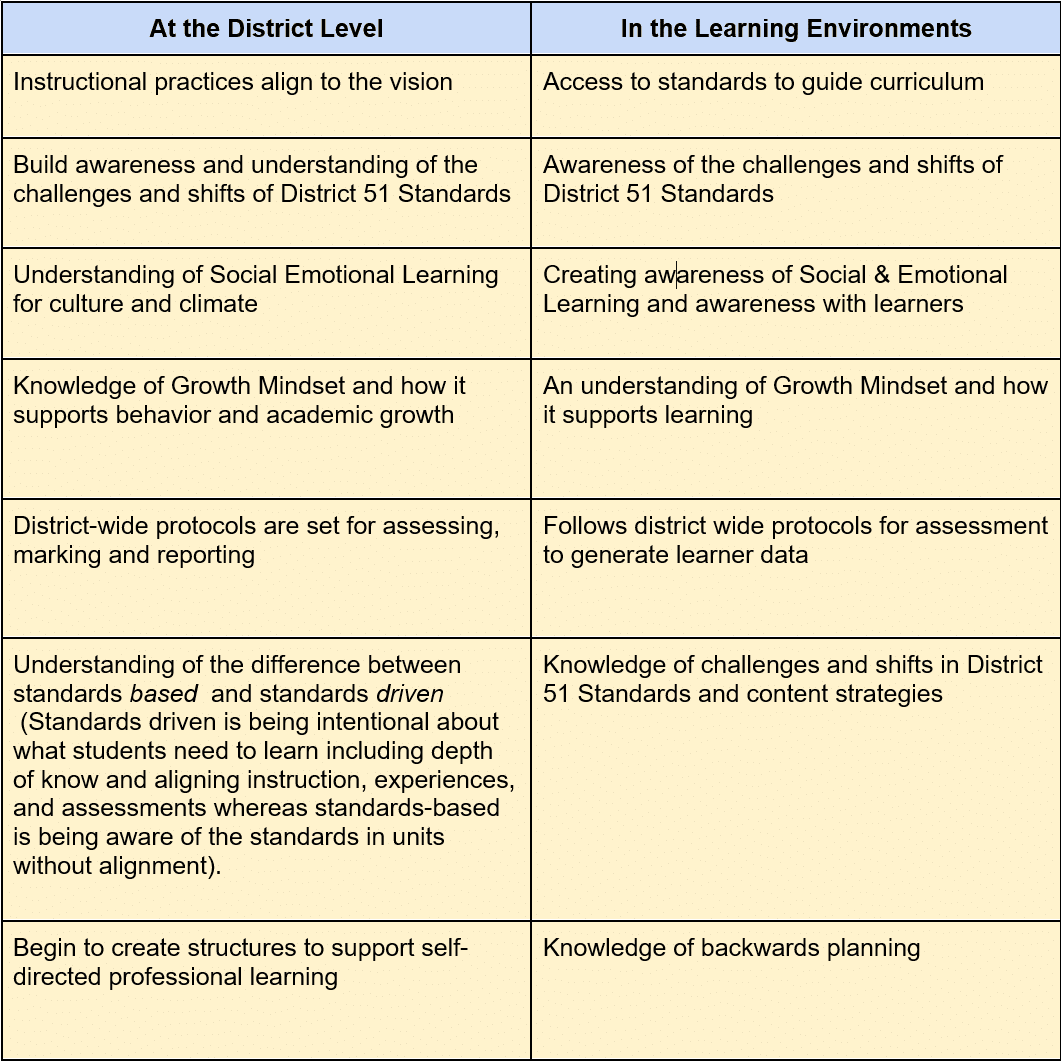
Supporting Effective Practices: Demonstration schools get more intensive support, and all other schools and teachers can take advantage of Design Labs to build skills in practices related to growth mindset, workshop instructional models, and the practices for self-directed learning such as codes of cooperation and standard operating procedures. (See upcoming article Supporting Teachers at D51: A Conversation with the Professional Learning Facilitators for more information.) There are also efforts underway to revitalize professional learning communities within schools and to prepare principals to be ready to take on strong instructional leadership as teachers begin to look at student work, calibrate proficiency, and identify areas for continuous improvement.
Again, the outline of steps in Supporting Effective Practices phase as described by D51:
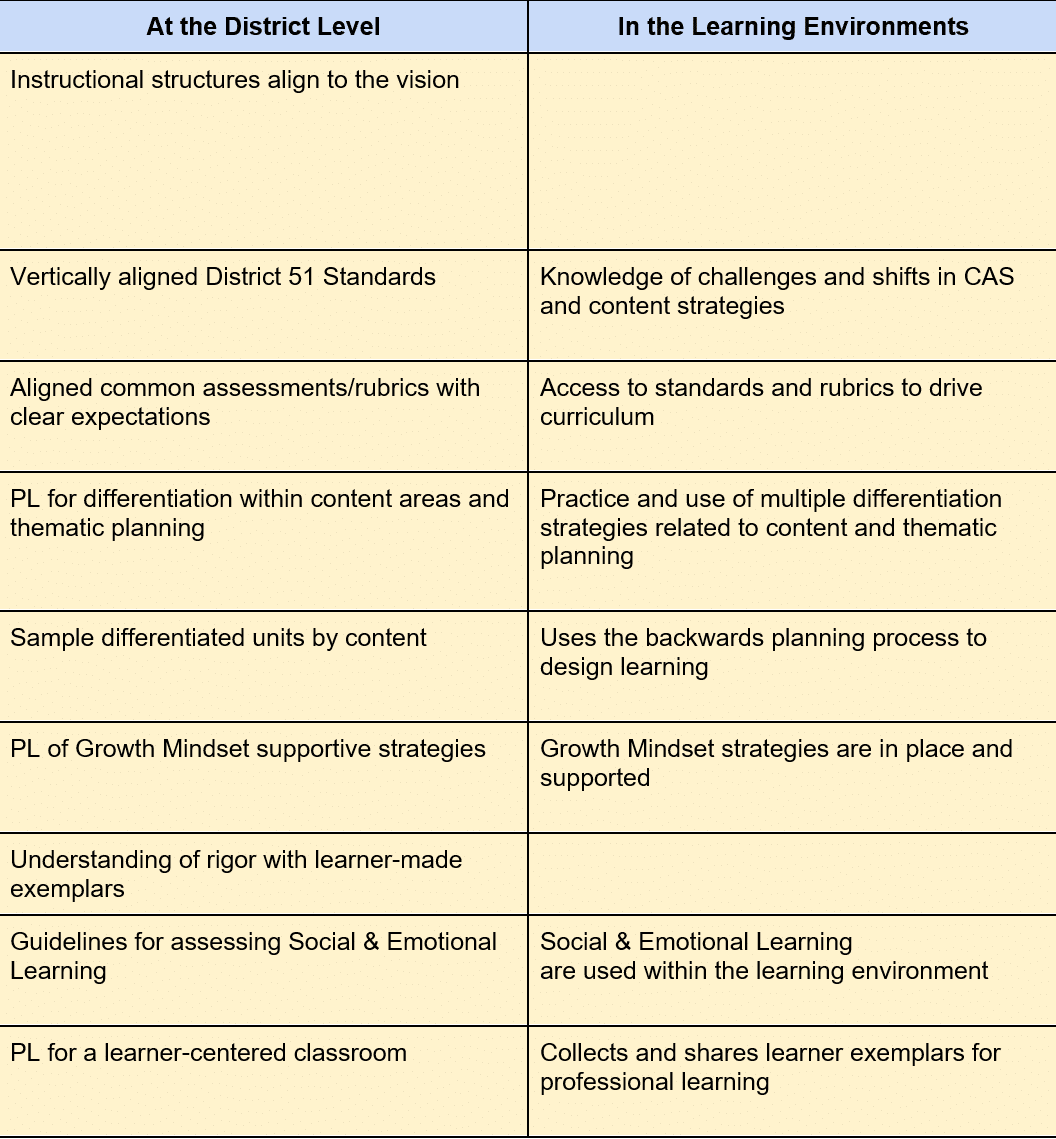
Building Performance-Based System: The goal of this work is to create the bones of the transparent, coherent, and aligned system. There are a number of very important pieces to this work that are all underway, which means that the process is both simultaneous and iterative. The pieces of the P-BL include: graduate profile and corresponding graduation competencies, district-wide shared vision (complemented by school-wide shared vision), guiding principles, competency infrastructure (graduation competencies and standards with corresponding rubrics), and the Teaching and Learning Framework that defines the structure and processes.
The steps in Building the Performance-Based System phase as described by D51 are below:
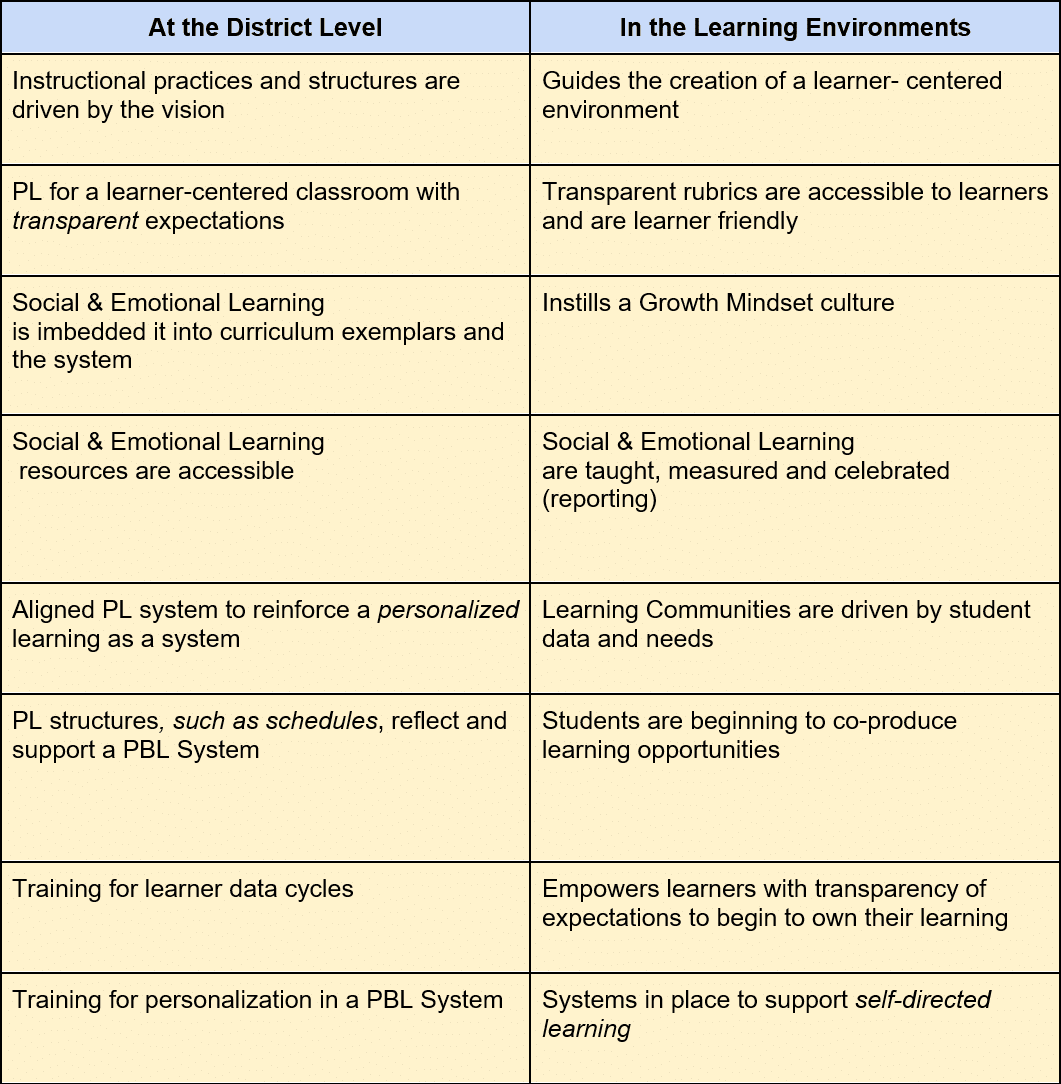
Beginning Personalized Learning: D51 is very specific about discussing personalized learning as something that will happen in the future. They don’t want to talk about personalizing education unless it is something that all students will benefit from – not a little bit here and a little bit there. They want to have a coherent pedagogical approach to personalization to ensure the quality of choices and opportunities students have. Most of all, they want to to make sure that the Performance-Based Learning system is in place so they can make sure personalization is actually adding up to something: students reaching, demonstrating, and advancing upon mastery.
Refining Our System: This will be a process of mid-course corrections, a continuous improvement of the P-BL system itself, and, as we see in other districts, waves of capacity building, improvement, and innovation regarding instruction and assessment.
Pulling Together the Team
Everyone seems to be working toward building the performance-based system in D51. School board members are knowledgeable and enthusiastic. District leadership is reorganizing to clarify roles, scope, and authority as well as how they communicate and make decisions. Teams on a variety of areas of work have been created, and they are in the process of identifying how these teams intersect.
Superintendent Steve Schultz recruited Rebecca Midles from Lindsay Unified (and before that, RISC and Highland Tech) to join D51 as the Executive Director of Performance-Based Systems to build capacity internally. A team of professional learning facilitators (teachers on special assignment) were pulled into the team: Heather Flick, Amy Shephard-Fowler, and Bil Pfaffendorf (with experience at Lindsay and Westminster formerly known as Adams 50). They are designing the professional learning system as well as contributing to much of the design process of the P-BL system to ensure alignment.
And then there are the educators at the demo schools.
Demonstration Schools
D51 has been walking a tightrope of investing in demonstration (or demo) schools while still ensuring that any school can move forward. This isn’t a district with a flood of federal dollars to support personalized learning coaches for each school. Demonstration status means that teachers have voted to move forward – many at 95 or even 100 percent support – and that principals have the opportunity to meet together to talk about and address emerging issues.
The Demo School Principals Meeting is serving a lot of functions. It’s where people share resources such as Tool Time for Education by Langford and a video of a teacher confessing that he finally understood that he was the problem in the classroom, not the students. It’s also an opportunity to reflect, build understanding, and identify areas of tension (or as D51 thinks about it – as opportunities to move their district toward their vision). At the meeting I attended, the principals paired off then square-paired to share how they describe performance-based learning to their constituencies and to explore what personalized learning means. They were beginning the early discussions about personalization (the fourth phase of implementation), so the demo school principals had a deep understanding of what personalized learning means well before they began to “grow into it”.
Understanding this Implementation Strategy
Take a breath. That is the “what” D51 is doing right now. However, I think it is helpful to go a little deeper to look at why they’ve designed it this way and some of the lessons they are learning along the way.
D51 has created this implementation strategy for a number of reasons:
- Urgency: They have momentum and they don’t want to lose it with a long implementation roll out.
- Enthusiasm: The schools and educators that are on board would prefer to get going even if they know that the P-BL system won’t be designed and ready to begin implementation until fall of 2017. They’d prefer to be moving forward where they can.
- Open Learners: I met an extraordinary set of educators at D51. These innovators and early adopters all understand that they are on a steep trajectory curve and they are along for the ride. Knowing the phases while having the time to deepen their learning is actually a luxury. They all know they are walking around way outside their comfort zones, a little cloud of confusion hanging over their heads, and are fully aware that this is what it means to learn and work in a learning organization.
Other districts shorten the process of laying the foundation of the growth mindset too much and pay for it later.
- Valuing the Process of Laying the Groundwork: D51 thinks it is very important to take the time to lay the foundation of growth mindset and the right set of values. Midles remarked that other districts shorten this process too much and pay for it later. Integrating the growth mindset in school culture might take longer in some schools than others, and that’s okay.
- Iterative Process for Designing the System: There are several pieces that need to be developed, all of which are interdependent. No matter how it is done, it will require iteration. Thus, D51 is working on them simultaneously with attention to identifying the points of intersection.
- Investing in Ownership: Even though they brought Midles in to help guide the process, there is a commitment to ownership and ensuring the D51 model builds on what they had in place. Thus, the district isn’t designing the system in its conference rooms and sharing it with the schools. An inclusive, co-constructed design process is an important part of building ownership and tapping into the expertise and creativity of the educators across D51.
Below are some of the highlights of conversations I had throughout the week that helped me understand the reasoning behind the implementation strategy as well as lessons being learned along the way.
Emphasis on Demonstration, Not Piloting
D51 made an important choice when they decided to have seven demonstration schools instead of pilots. Pilots can be interpreted as experiments. Pilots are often organized around a set of classrooms rather than school-wide – more likely than not setting up a competency-based approach for failure as it requires school-wide changes. Most problematic, everyone not in the pilot classrooms can just sit back and watch.
In the D51 demonstration schools, teachers voted to move forward. Five schools had 95 percent support or above. It’s a school-wide effort of educators who want to see P-BL work. It’s designed for success. Schultz explained, “With the vote, educators at the demonstration schools agreed to tolerate the ambiguity that comes along with change.” D51 selected a mix of schools with different social-economic status, different ages, and different neighborhoods.
Don’t Underestimate Laying the Foundation
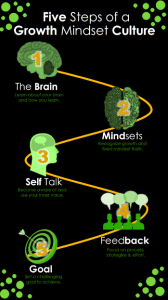 Midles emphasized, “Districts need to stay in phases 1 and 2 as long as they can. The teachers in the demonstration schools will be learning what it means to integrate growth mindset and build new practices, but that doesn’t mean that they have mastered them to the point that they are routine. For all the teachers in the other schools, you want to keep those phases open and valued within the districts for years and years so that it is always okay for those last teachers who were waiting and seeing what was going to happen to build those schools.” That’s why it’s important to think of these phases as simultaneous, not sequential. There is likely always to be someone during the first five, seven, or even ten years who is just starting to climb on the bandwagon, and they need the opportunity to learn the foundational concepts and effective practices. “If we want the system to be personalized, then we have to build the capacity for gradual release, voice, and choice for teachers, as well,” added Midles. “If you close down those phases too early you will get frustration.”
Midles emphasized, “Districts need to stay in phases 1 and 2 as long as they can. The teachers in the demonstration schools will be learning what it means to integrate growth mindset and build new practices, but that doesn’t mean that they have mastered them to the point that they are routine. For all the teachers in the other schools, you want to keep those phases open and valued within the districts for years and years so that it is always okay for those last teachers who were waiting and seeing what was going to happen to build those schools.” That’s why it’s important to think of these phases as simultaneous, not sequential. There is likely always to be someone during the first five, seven, or even ten years who is just starting to climb on the bandwagon, and they need the opportunity to learn the foundational concepts and effective practices. “If we want the system to be personalized, then we have to build the capacity for gradual release, voice, and choice for teachers, as well,” added Midles. “If you close down those phases too early you will get frustration.”
Personalization: The Last Frontier
Midles is constantly emphasizing to everyone she speaks with that personalization is a phase that doesn’t begin until the P-BL system is in place. Yes, there will be aspects of it, including more opportunities for self-directed learning and more flexible pacing the minute teachers start implementing the core set of effective practices (shared vision, code of cooperation, and standard operating procedures) and the workshop model.
However, the full concept of personalization is a system-wide approach in which students fully get the support they need to succeed, receive coaching in the skills necessary to be lifelong learners, and are engaged and motivated through rich opportunities for voice, choice, and co-design. D51 understands personalization as a commitment of schools and districts to ensure that students are successful. In fact, as I listened to discussions about personalization, I wondered if the concept of accountability was wrapped into it. Midles cautioned, “We don’t want to promise personalized learning until the full P-BL system is in place and transparent. One of the most important elements of the system we need is transparent, calibrated common assessments. We can’t guarantee an equitable personalized system without it. We don’t have a transparent, learner-centered system until it becomes fully systemic. That’s when we can start using the language of personalized learning to describe our system and the quality of education students are getting.”
The only way that schools can monitor equity – at a minimum ensuring that historically underserved populations are getting a quality education and progressing towards graduation – is when the Performance-Based Learning system can be put fully into place. Without it, personalization can quickly slip into the new realm of inequity – different and not equally valuable to learning. The question that D51 will be taking on after they have designed and implemented the P-BL system is what a system of personalized learning looks like where students get the support they need, the coaching and opportunities to take responsibility for their learning, and the confidence that the same expectations of mastery are being held for every student.
Emphasis on Structure of Teaching and Learning
If I was to map out the journey most districts have taken on the path to P-BL, I would create the Swamp of Unpacking and Revising the Standards and Competencies, where many districts get stuck and lose their way. The precious time of educators that is spent revising the wording of the competencies, standards, and rubrics could be used to test them out and to open the door to the much richer conversation of calibrating the understanding of proficiency, instructional strategies, and assessment literacy.
D51 is not spending a lot of time worrying about the design or texture of the competency framework. They’ve adopted the Colorado Academic Standards as the academic core to be complemented by an integrated framework of Social & Emotional Learning and Habits of Mind (this is important to remember: when you read Social & Emotional Learning, it includes the Habits as well). There is a team thinking through the structure for the rubrics that can then be developed to begin the process of calibrating proficiency across the district and empower students. Leigh Grasso, Director of Academic Achievement & Growth, explained, “We knew it was important to not only build rubrics but to make sure that effective instructional practices were being used in the classrooms. This is why defining the instructional practices in the Teaching and Learning Framework is so important.”
D51 is putting a lot of creative resources toward co-designing the Teaching and Learning Framework with representation from both demonstration and non-demonstration K-12 sites, and it is now being vetted by teachers across the district. This Framework essentially describes the system and how it will work. In some ways, it is the map of the P-BL system and will help to identify all the points of alignment that are needed. It’s the tool that will spark conversations about when and how students are assessed for their learning and when and how students are able to advance upon mastery even into higher grade levels.
Stay tuned – when this document is complete, it will be helpful to every district making the move to competency education.
Read the Entire Series:
Post #1 – Designing Performance-Based Learning at D51
Post #2 – Building Consensus for Change at D51
Post #3 – The Vision of Performance-Based Education at D51
Post #4 – Holacracy: Organizing for Change at D51